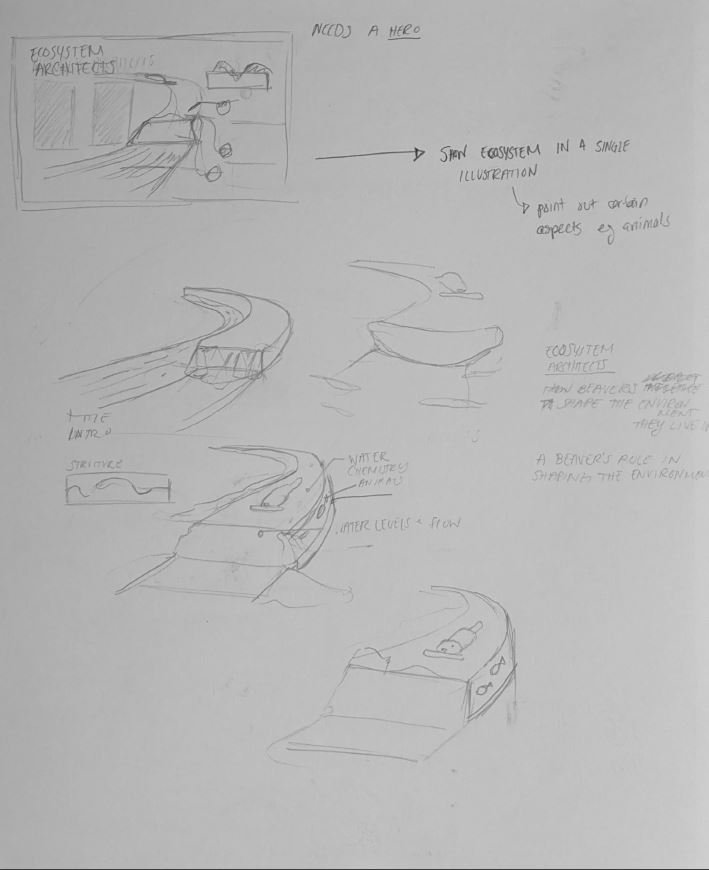
Ecosystem Architects
Purpose
To inform individuals about the importance of beavers for the survival of other organisms in the environment. It provides the audience with an understanding of the purpose of beaver dams, how the building of these dams alters the landscape, as well as the resulting impact of these environmental changes on other living organisms.
Client
Jodie Jenkinson
Date
October 2020
Medium
Infographic
Tools
Procreate, Photoshop, Illustrator
Primary Audience
Lay
Inspiration
The idea for this project came from people in my hometown neighbourhood disliking beavers due to them taking down trees in their yards and causing floods nearby. This prompted me to want to show others the importance of beavers to the environment, highlighting their positive attributes. I was initially inspired by images showing the inside of beaver’s nesting sites and their underwater entrances.
Initial Sketches
I began by sketching different layouts for the piece, and came across the idea of showing a curved stream. This figure would be able to have different animal scattered around it to further discuss the importance of beavers to these animals.
Rough Layouts
Different compositions were explored for the final infographic, specifically focusing on how to curve the stream running into the page in a way that would leave the eye into the piece nicely.
Comprehensive Sketch
A comprehensive sketch was created to finalize the copy and layout for the piece. This sketch was later used to guide the final rending of the piece and which components would need to be included.
References
Collen, P., & Gibson, R. (2000). The general ecology of beavers (Castor spp.), as related to their influence on stream ecosystems and riparian habitats, and the subsequent effects on fish – a review. Reviews in Fish Biology and Fisheries, 10(4), 439–461. https://doi.org/10.1023/a:1012262217012
Gurnell, A. (1998). The hydrogeomorphological effects of beaver dam-building activity. Progress in Physical Geography, 22(2), 167–189. https://doi.org/10.1191/030913398673990613
Müller, G., & Watling, J. (2016). The engineering in beaver dams. River Flow 2016. https://doi.org/10.1201/9781315644479-326
Rosell, F., Bozser, O., Collen, P., & Parker, H. (2005). Ecological impact of beavers Castor fiber and Castor canadensis and their ability to modify ecosystems. Mammal Review, 35(3-4), 248–276. https://doi.org/10.1111/j.1365-2907.2005.00067.x
Weber, N., Bouwes, N., Pollock, M. M., Volk, C., Wheaton, J. M., Wathen, G., & Jordan, C. E. (2017). Alteration of stream temperature by natural and artificial beaver dams. Plos One, 12(5). https://doi.org/10.1371/journal.pone.0176313
Fairbank-Brown, A. (2020, June 8). Ducks in flight over the lake with sunbeams shinning on them. Unsplash. Retrieved October 5, 2020, from https://unsplash.com/photos/bMAm85GrjDA.
Gibson, K. (2017, November 16). Ducks (1). Unsplash. Retrieved October 5, 2020, from https://unsplash.com/photos/K-l5Q3ifrNc.
Kachur, T. (2017, May 18). Beavers are dam important for the ecosystem. CBC News. Retrieved October 5, 2020, from https://www.cbc.ca/news/canada/why-beavers-matter-1.4121550
National Geographic. (2012, December 28). Beaver Genius | National Geographic [Video]. YouTube. Retrieved October 3, 2020, from https://www.youtube.com/watch?v=jBaXlyq3E8M
Langley, L. (2017, December 21). Beavers Have Vanilla-Scented Butts and More Odd Facts. National Geographic. Retrieved October 4, 2020, from https://www.nationalgeographic.co.uk/animals/2017/12/beavers-have-vanilla-scented-butts-and-more-odd-facts.
McLeod, B. (2020, July 11). Beaver swimming through water. Unsplash. Retrieved October 4, 2020, from https://unsplash.com/photos/tciEt4IvdmM.
Müller, G., & Watling, J. (2016). The engineering in beaver dams. River Flow 2016. https://doi.org/10.1201/9781315644479-326
National Park Service. (2018, March 29). Epizootic hemorrhagic disease. Retrieved October 4, 2020, from https://www.nps.gov/articles/ehd.htm
Ontario Nature. (2020, February 7). Green Frog. Retrieved October 7, 2020, from https://ontarionature.org/programs/citizen-science/reptile-amphibian-atlas/green-frog/.
Randall, B. (2020, May 12). Beavers, Trout, and a Changing Climate. The National Wildlife Federation Blog. Retrieved October 6, 2020, from https://blog.nwf.org/2020/05/beavers-trout-and-a-changing-climate/.
Richmond, A. R. (n.d.). Snapping Turtle (Chelydra serpentina). UMass Amherst. Retrieved October 7, 2020, from https://www.bio.umass.edu/biology/research/gbi/snapping-turtle-chelydra-serpentina.
Rosell, F., Bozser, O., Collen, P., & Parker, H. (2005). Ecological impact of beavers Castor fiber and Castor canadensis and their ability to modify ecosystems. Mammal Review, 35(3-4), 248–276. https://doi.org/10.1111/j.1365-2907.2005.00067.x
Washington Department of Fish and Wildlife. (n.d.). Beaver. Retrieved October 5, 2020, from https://wdfw.wa.gov/species-habitats/species/castor-canadensis#living.






